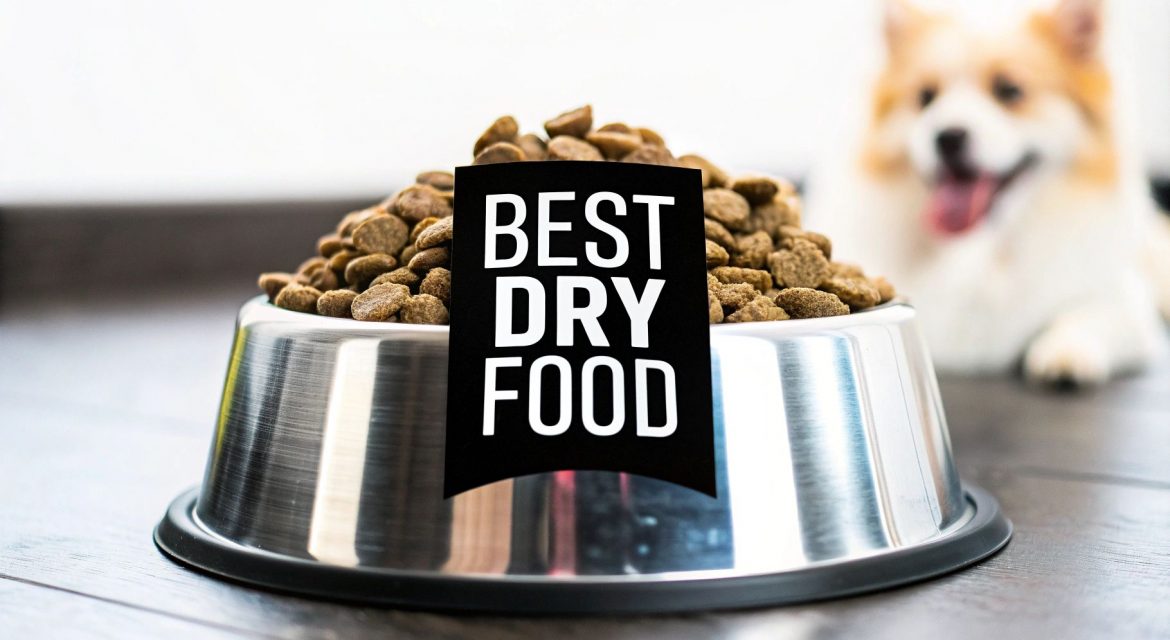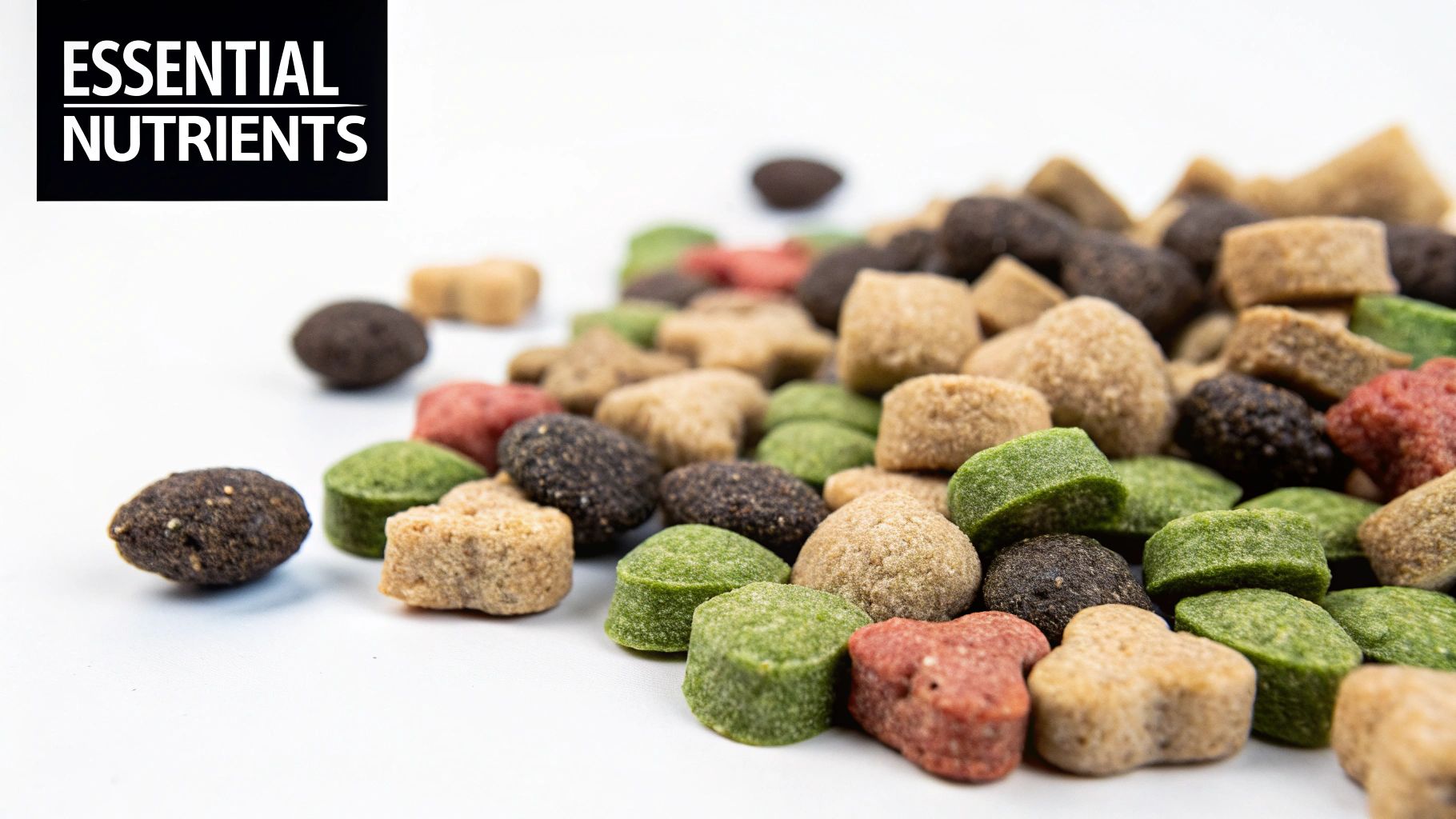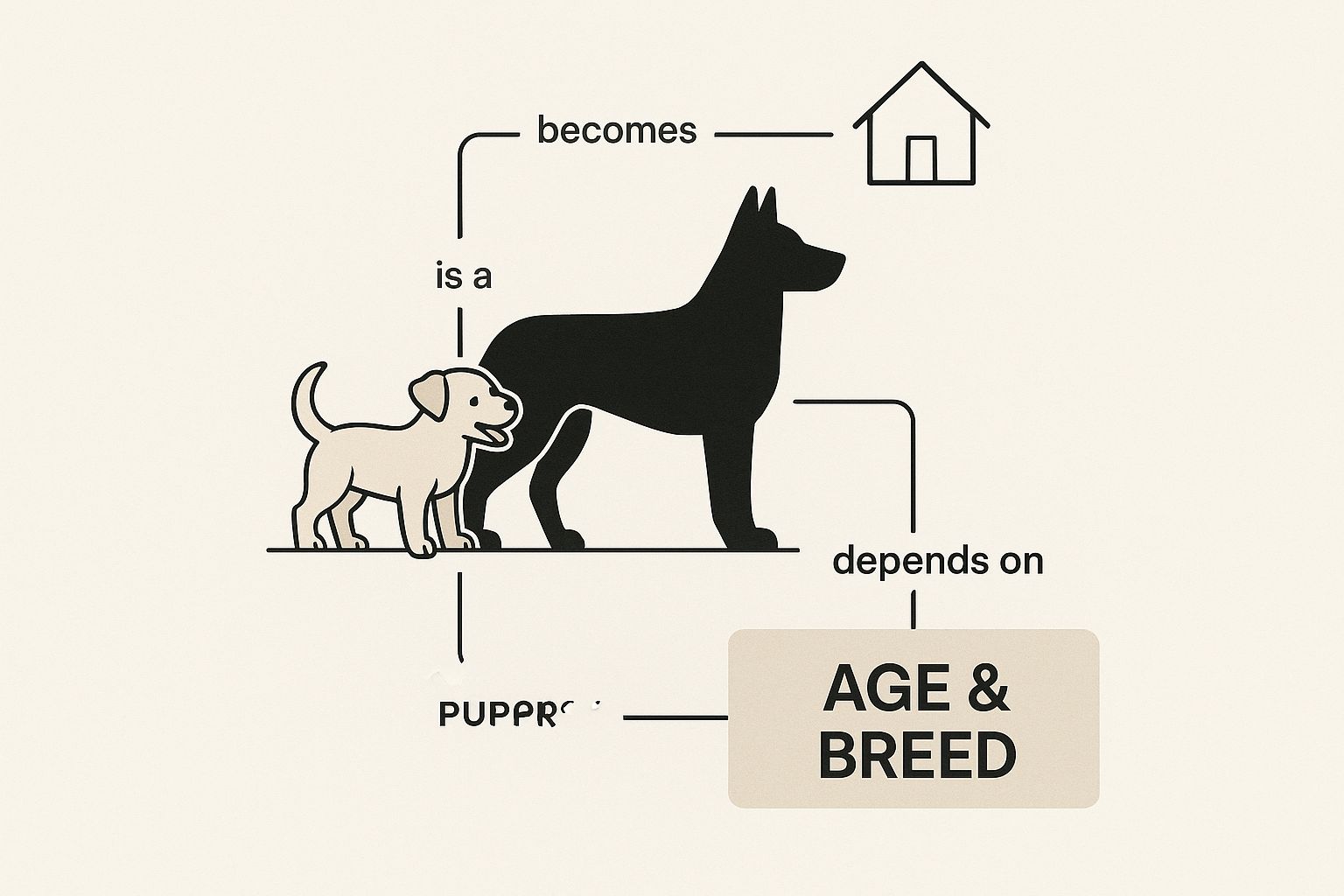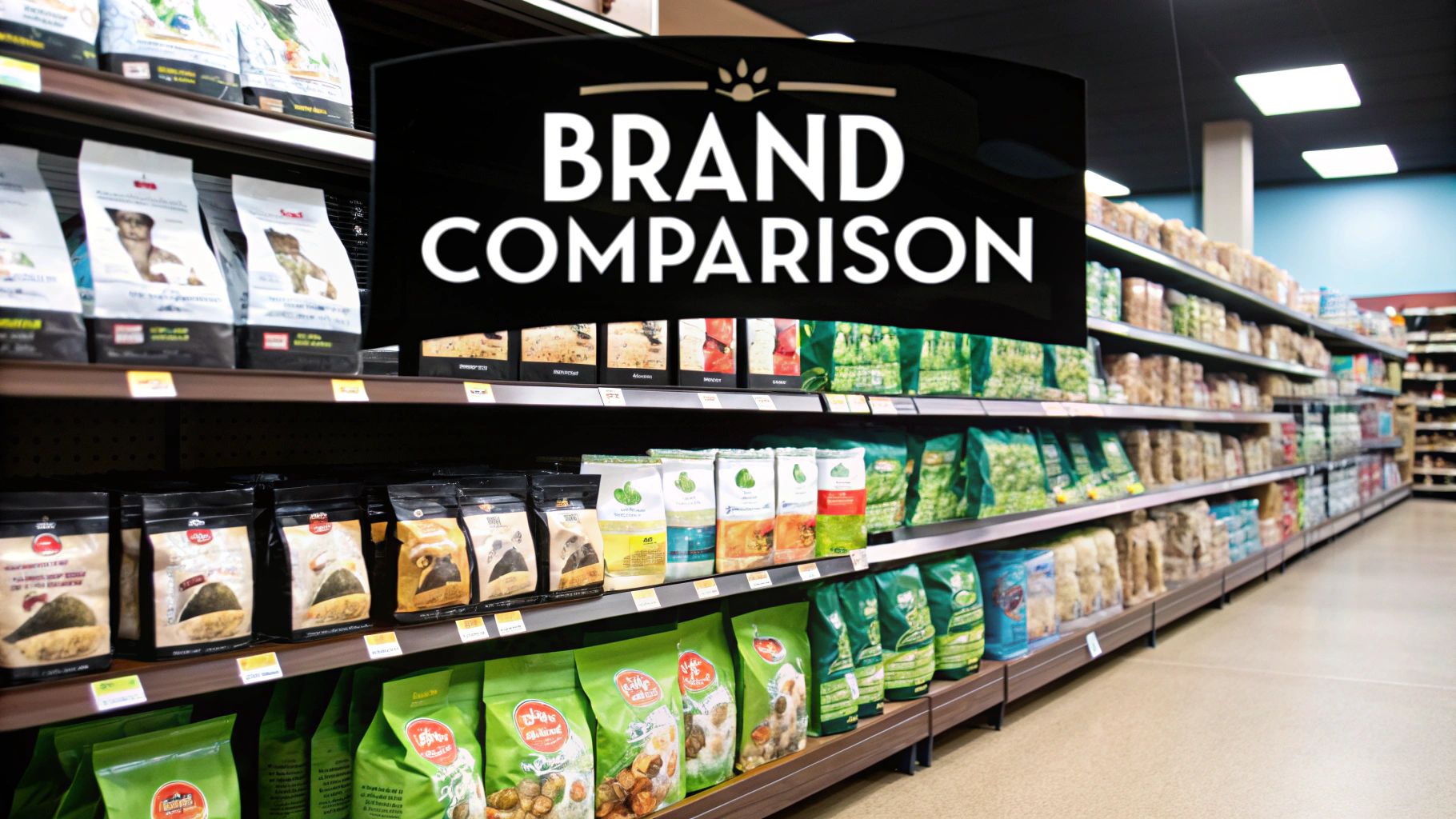Wandering down the pet food aisle can feel like a mission impossible, but we're going to let you in on a secret: finding the best dry food for dogs isn't about some single, magical brand. It’s about finding the perfect nutritional match for your one-of-a-kind companion. We're here to help you do just that, turning what feels like a confusing chore into a confident choice.
Finding What's Best for Your Dog
Welcome! We know that stare-down with a wall of kibble bags all too well. Every package seems to shout promises, but you’re here because you want to make the right choice for the dog who brings so much joy into your life. We completely get it.
Choosing your dog's food is one of the most important decisions you'll make. It’s not just about filling a bowl; it’s about giving them the building blocks for a long, happy, and vibrant life with you. What you feed them has a direct line to their energy levels, their long-term health, and even the sparkle in their eyes.
A New Standard of Care
Something wonderful has happened in recent years: we’ve stopped seeing our dogs as just pets and started treating them like the family they are. This shift has thankfully raised the bar for dog food quality across the board.
This growing "humanisation" trend means we, as owners, are more invested in our dogs' well-being than ever before. It's also fuelled a massive surge in dog ownership here in the UK. The pet dog population jumped from 9 million in 2019 to an estimated 13 million in 2024—that’s a whopping 44% increase in just five years. You can discover more about the UK's growing love for dogs and its market impact.
The great news? This trend has led to far better options for all of us. Food companies are now offering higher-quality ingredients and more specialised formulas than ever before, giving you a fantastic range of choices to find the perfect fit.
The single "best dry food for dogs" doesn't actually exist. The truly best food is the one that meets your individual dog's health needs, fits their life stage, and helps them absolutely thrive.
Your Path to a Confident Choice
Our mission is simple: to arm you with the knowledge to walk down that pet food aisle and know exactly what you’re looking for. We'll break down everything from decoding confusing labels to matching nutrition to your dog’s specific needs. Together, we'll turn this overwhelming task into an empowering act of love.
How to Read a Dog Food Label with Confidence
Walking down the pet food aisle can feel like you’re about to sit an exam you haven’t revised for. The back of a dog food bag, with all its tiny print and technical jargon, might as well be in another language. But don't worry, we're going to translate it together. Think of this as your personal decoder ring for dog food labels.
We want you to feel empowered, not overwhelmed. By the end of this, you'll be able to see straight past the flashy marketing on the front of the bag and get to the real story on the back. You'll know exactly what you're putting in your dog's bowl and feel totally confident you’re picking out the best dry food for them.
This infographic breaks down a simple but crucial idea: a dog's nutritional needs change dramatically depending on their age and size.
As the image shows, a bouncy little puppy has very different dietary requirements from a fully-grown adult dog, and that’s a massive factor when choosing their food.
The All-Important Ingredient List
The very first place your eyes should go is the ingredient list. The ingredients are listed by weight, from heaviest to lightest, before they're cooked. This means the first five ingredients paint the clearest picture of what the food is really made of.
You want to see a high-quality, named protein source right at the top of that list. Look for specific words like 'deboned chicken', 'lamb', 'salmon', or 'beef'—not vague terms. If the first ingredient is a carbohydrate like corn or a mysterious 'meat and animal derivatives', it’s a big hint that the food might be on the lower-quality side.
Demystifying Common Ingredient Terms
The language on these labels can be deliberately tricky. Let's clear up a few common terms you’ll run into so you know exactly what they mean for your dog.
- Meat Meal: This might sound a bit off-putting, but a named 'meat meal' (like 'chicken meal' or 'lamb meal') is actually a fantastic, concentrated source of protein. It’s made by rendering the meat, which cooks out the water and fat, leaving a protein-rich powder. It’s an incredibly effective way to pack protein into dry kibble.
- By-Products: This term often makes people nervous. 'Poultry by-products' can include nutrient-dense organ meats like hearts and livers. The problem is, it can also include less desirable bits like feet and feathers. The lack of specificity is the real issue here; quality brands that use organ meats will usually just list them by name (e.g., 'chicken liver').
- Fillers: These are cheap, low-nutrient ingredients used to bulk up the food and keep costs down. Common fillers are things like corn, wheat gluten, and soy. While they aren't necessarily harmful, they offer very little nutritional benefit compared to quality complex carbohydrates like sweet potatoes or whole grains like brown rice.
A key takeaway is that transparency matters. Specificity is a sign of quality. "Chicken" is good. "Meat" is vague. "Chicken liver" is great. "Animal by-products" is a red flag.
Understanding the Guaranteed Analysis
Next up, you'll find the 'Guaranteed Analysis' section. This is basically the nutrition facts panel for your dog's food, showing the minimum percentages of protein and fat, and the maximum percentages of fibre and moisture.
This part is crucial, but it needs a little bit of context. Because these are "as-fed" values, they include all the moisture in the food. Dry food usually has around 10% moisture, whereas wet food can be up to 78% moisture. This massive difference makes it tricky to compare kibble to canned food directly. If you're weighing up the options, you can dive deeper in our guide on wet versus dry dog food.
For dry food, here’s a general guide to what these numbers mean for an adult dog:
| Nutrient | What It Does for Your Dog | What to Look For (Adult Maintenance) |
|---|---|---|
| Crude Protein | Builds and repairs muscles and tissues. | A minimum of 18-25% is typical. Active or working dogs may need more. |
| Crude Fat | Provides energy and supports skin and coat health. | Look for at least 10-15%. Omega-3 and Omega-6 are vital fats. |
| Crude Fibre | Aids in healthy digestion and bowel regularity. | A maximum of 3-5% is generally ideal for most dogs. |
When you combine your new know-how on the ingredient list with an understanding of the Guaranteed Analysis, you’ve got everything you need. You can now confidently pick up any bag, decode its label, and make a brilliant choice for your best friend.
Matching Food to Your Dog's Life Stage and Size
Think about it this way: you wouldn't feed a growing baby the same diet as a professional rugby player. Their bodies have completely different jobs to do. It’s exactly the same with our dogs. A tiny, bouncy Jack Russell puppy and a wise, grey-muzzled Great Dane simply don't have the same nutritional needs.
This is why a one-size-fits-all approach to dog food just doesn’t cut it. Choosing the right food is about honouring where your dog is in their life journey. It's one of the most powerful ways we can support their health, from their very first wobbly steps to their comfortable golden years.
Let's break down why matching food to life stage and size is a true cornerstone of finding the best dry food for dogs.
Fuel for the Future: Puppy Nutrition
Puppies are little bundles of pure potential, and their bodies are working overtime. They are building everything from scratch—strong bones, lean muscles, developing organs, and a robust immune system. This incredible growth spurt requires a specific, high-octane nutritional profile.
Think of puppy food as the ultimate construction kit. It’s packed with more calories to fuel their boundless energy and higher levels of protein to build all that new tissue.
Here’s what makes puppy-specific formulas so crucial:
- Higher Protein: Essential for building strong muscles and repairing tissue as they grow.
- Increased Fat Content: Provides a concentrated source of energy for all that playing and exploring.
- Specific Mineral Balance: Contains carefully controlled levels of calcium and phosphorus, vital for healthy bone and joint development. Getting this ratio right is especially important for preventing developmental issues in larger breeds.
Choosing a dedicated puppy formula isn't just a suggestion; it’s the foundation for a healthy adult life. It gives them the best possible start, setting them up for strength and vitality for years to come.
The Long Haul: Adult Dog Maintenance
Once your dog reaches adulthood—usually around one year for small breeds and up to two years for giant breeds—their nutritional needs shift. The frantic construction phase is over, and the focus turns to maintenance. Their diet is now all about preserving their health, maintaining a lean body condition, and fuelling their daily adventures.
Adult dog food is formulated for this exact purpose. It provides a balanced diet that helps prevent weight gain while still delivering all the essential nutrients needed for long-term well-being. This is the stage where you fine-tune their diet based on their unique energy levels—a working sheepdog will need more fuel than a chilled-out bulldog.
The goal for an adult dog is balance. We’re no longer building the house; we're just maintaining it. Their food needs to provide exactly what's needed for daily upkeep without overloading their system with excess calories that could lead to weight gain.
Grace and Comfort: Senior Dog Support
As our beloved companions enter their golden years, their bodies change again. Their metabolism often slows down, their joints might get a bit creaky, and they may become less active. Senior dog food is thoughtfully designed to support them through these changes with grace and comfort.
These formulas typically feature:
- Fewer Calories: To help prevent weight gain in less active dogs.
- Joint Support: Often enriched with supplements like glucosamine and chondroitin to help maintain cartilage and support joint mobility.
- High-Quality Protein: To help maintain muscle mass, which can decline with age.
- Increased Fibre: To aid digestion and promote bowel regularity.
Switching to a senior diet is an act of empathy. It shows you understand their changing needs and are committed to keeping them comfortable and happy as they age.
Size Matters: Small, Medium, and Large Breeds
Beyond age, a dog's breed size plays a massive role in their dietary needs. A Chihuahua's tiny mouth and fast metabolism are worlds away from a Bernese Mountain Dog's large frame and slower growth rate.
Small Breed Formulas: These foods often have a higher calorie density because small dogs have faster metabolisms and burn through energy more quickly. The kibble is also much smaller, making it easier for them to chew and reducing the risk of choking.
Large and Giant Breed Formulas: These are specially designed to support controlled growth. They have slightly lower fat content and a very precise calcium-to-phosphorus ratio to ensure bones and joints develop at a steady, healthy pace. Growing too quickly can put immense strain on a large dog's skeletal frame.
This attention to detail is part of a larger trend. Today's pet owners are more discerning than ever, driving a market where quality and transparency are key. Premium dog foods with organic ingredients, high protein content, and clear nutritional information are becoming the norm as we increasingly align our pets' diets with our own healthy eating habits. You can read more about these evolving trends in the UK pet food market.
Ultimately, choosing a food that is specific to your dog's life stage and size is one of the easiest and most effective ways to support their lifelong health. It ensures they get exactly what they need, right when they need it.
Right, so you've got the hang of reading a dog food label. Excellent. Now for the real detective work: figuring out what those ingredients actually mean for your dog. This is where the magic happens, separating the top-shelf stuff from the budget fillers.
Think of it this way: you're about to become a pro at spotting the nutritional heroes and sidestepping the villains. Once you know what to look for, you'll be able to glance at any bag and get a pretty good idea if it’s worth your money.
The Power of Protein
Protein is the absolute foundation of your dog's health. It's what builds and repairs muscle, keeps them strong, and fuels their daily adventures. But here's the catch: not all protein is created equal. The key is in the name.
When you look at that ingredients list, you want to see named protein sources right at the top. We're talking about things like:
- Deboned Chicken
- Salmon
- Lamb Meal
- Grass-fed Beef
Seeing a specific animal tells you exactly what’s in the bag. A term like 'chicken meal' is also a good sign. It's just chicken with the water removed, which makes it a super-concentrated source of protein.
The red flag you want to watch out for is vague language. If you see "meat and animal derivatives," be wary. This is a catch-all term that could include anything from high-quality organ meat to much less desirable bits and pieces. Without transparency, you just don't know what you're getting.
Understanding Carbohydrates and Fats
Carbohydrates are your dog’s fuel for walks, playtime, and those classic zoomies around the garden. And just like with protein, the source is what really counts. You want to see complex carbs that deliver sustained energy and extra nutrients.
Look for wholesome ingredients like sweet potatoes, peas, brown rice, and oats. These are digested slowly and are full of good stuff like vitamins and fibre. The ingredients to question are cheap fillers—corn, wheat gluten, and soy—which tend to offer empty calories and not much else.
Fats are another vital energy source, crucial for brain health, healthy skin, and a shiny coat. You want to see healthy, named fat sources like chicken fat or sunflower oil. Even better are foods rich in omega-3 and omega-6 fatty acids, which usually come from things like salmon oil or flaxseed.
Think of it like this: A high-quality food uses ingredients you'd recognise from a healthy human diet—real meat, whole vegetables, and healthy oils. A lower-quality food often relies on vague terms and cheap fillers you wouldn't typically find in your own pantry.
Now, let's look at what good and not-so-good ingredients look like side-by-side. This simple comparison can make spotting quality on a label second nature.
Good Ingredients vs. Ingredients to Question
| Ingredient Type | Look for These (High Quality) | Question These (Lower Quality) |
|---|---|---|
| Protein | Named animal sources (e.g., chicken, beef, salmon), named meal (e.g., lamb meal). | Vague terms like "meat and animal derivatives" or "poultry by-products." |
| Carbohydrates | Whole grains (brown rice, oats), sweet potatoes, peas, lentils. | Cheap fillers like corn, wheat gluten, soy, generic "cereal." |
| Fats | Named fats (e.g., chicken fat), salmon oil, flaxseed, sunflower oil. | Unspecified "animal fat" or "vegetable oil." |
| Preservatives | Natural preservatives like mixed tocopherols (Vitamin E), rosemary extract. | Chemical preservatives like BHA, BHT, ethoxyquin. |
| Additives | Fruits and vegetables for natural vitamins and antioxidants. | Artificial colours, artificial flavours, added sugars (corn syrup, sucrose). |
Seeing it laid out like this really drives the point home, doesn't it? It’s all about specific, recognisable ingredients versus vague, cheap substitutes.
The Ingredient Red Flag List
Finding the best dry food for your dog is as much about what you avoid as what you include. The pet food market is huge—the dog food sector alone brings in nearly £2 billion a year. With a market that big, quality can vary massively, from genuinely premium foods to options that are, frankly, not great. You can explore more about the UK pet industry's incredible growth to get a sense of just how much choice is out there.
To help you cut through the noise, here are a few common red flags to steer clear of:
- Artificial Colours: Your dog doesn’t care if their kibble is rainbow-coloured. Dyes like Red 40 or Yellow 5 are only there to appeal to you, the human, and can sometimes trigger sensitivities.
- Artificial Flavours: If a food is made with quality ingredients like real chicken, it shouldn't need a spray-on flavour. This often signals that the core ingredients aren't very palatable on their own.
- Chemical Preservatives: Keep an eye out for BHA, BHT, and ethoxyquin. While they do the job, there are long-term health concerns. The best brands have moved on to natural alternatives like mixed tocopherols (which is just a form of Vitamin E) or rosemary extract.
- Added Sugars: Ingredients like corn syrup or sucrose are just empty calories. They serve no nutritional purpose and can lead to weight gain and dental problems down the line.
With this mental checklist, you’re ready to tackle any pet food aisle. For an even deeper dive into your dog's needs at every age, check out our comprehensive dog nutrition guide. You're now perfectly equipped to choose a food based on what’s actually inside the bag, not just what the marketing tells you.
Right, you've done the hard part. You’ve sifted through the countless options and picked out what you genuinely believe is the best dry food for your dog. That's a massive win, and it shows just how much you care.
But hold on. Before you scoop a full bowl of the new stuff, we need to cover the final, and most crucial, step: the transition.
Just imagine if you suddenly changed your entire diet overnight. Your stomach probably wouldn't be too happy about it, and it's the same for your dog. A quick switch can be a real shock to their digestive system, leading to tummy upsets and other issues nobody wants. We need to give their gut time to get used to the new ingredients.
Think of it as breaking in a new pair of walking boots; you wouldn't set off on a 10-mile hike straight away. A slow, steady approach is the key to making this a positive change for your best friend.
Your 7 to 10-Day Transition Plan
Patience is your best friend here. A gradual switch over a week or so is the kindest way to introduce a new diet. This gives your dog's digestive system all the time it needs to adapt without any drama.
Here’s a simple schedule that works wonders. Just remember to mix the old and new food together thoroughly in their bowl for every meal.
- Days 1-3: Start with a mix of 75% old food and 25% new food. This is just a gentle introduction, letting their system get acquainted with the new flavours and formula.
- Days 4-6: If everything seems fine, it's time to go 50/50 with the old and new food. You're at the halfway point, so this is a great time to check in and see how they're handling it.
- Days 7-9: Now, you can shift the balance to 25% old food and 75% new food. Your dog is now eating mostly their new kibble.
- Day 10 Onwards: If their digestion is stable and they seem happy, you're good to go with 100% of the new food. Success! You've officially made the switch.
Every dog is different. Some with sensitive stomachs might need a longer transition, maybe up to two weeks. On the other hand, some robust eaters might be perfectly fine with a seven-day switch. Just watch your dog—they'll let you know what pace works for them.
What to Watch For During the Switch
As you're mixing the food, you'll also need to put on your detective hat for a few days. Paying close attention to how your dog is acting and, well, what's coming out the other end will tell you everything you need to know.
Keep a close eye on these key things:
- Stool Consistency: This is the most direct sign of how things are going. Ideally, their poos should stay firm and well-formed. A little bit of softness can be normal at first, but if you see persistent diarrhoea or very loose stools, it’s a sign to slow the transition right down.
- Energy and Mood: A happy dog on a good diet has consistent energy. Watch out for any unusual sluggishness or a dip in their normal excitement for walks and playtime.
- Skin and Coat: While you won't see long-term coat benefits immediately, you should watch for any sudden itchiness, redness, or skin irritation. These could be early signs of a food sensitivity.
For a more detailed look at feeding amounts and schedules, our complete dog feeding guide has plenty of helpful tips to help you set up the perfect routine. By following this gentle process, you’re setting your dog up for a successful and happy transition to their new diet.
Answering Your Common Dog Food Questions
We know that after taking in all this information, you might still have a few questions buzzing around. That’s not just okay—it’s brilliant. It shows how much you care about getting this right for your dog, and we’re right there with you.
To help you feel even more confident, we’ve put together some of the most common questions we hear from UK dog owners. Let's tackle them with some clear, honest answers.
Is Grain-Free Dog Food Actually Better?
For a long time, "grain-free" felt like the ultimate seal of quality for dry dog food. And for a dog with a properly diagnosed grain allergy, it absolutely is the best choice. For these dogs, grains like wheat or corn can trigger everything from itchy skin to an upset stomach.
However, the truth is that most dogs digest high-quality, whole grains like brown rice, oats, and barley perfectly well. In fact, these ingredients are fantastic sources of energy and fibre.
The secret isn't about whether grains are present; it's about the overall quality of every single ingredient in the bag. A well-made food with healthy whole grains is often far better for your dog than a grain-free one bulked out with cheap potato starch or other fillers. So, always look at the entire ingredient list, not just a single marketing claim.
How Much Food Does My Dog Really Need?
This is one of the most important questions, and the answer is rarely as simple as what’s printed on the bag. Think of the feeding guide on the packaging as a starting point, not a strict rulebook.
Every dog is an individual, and the right amount of food depends on so many factors unique to them.
Consider your dog's:
- Age: Growing puppies and active adults need more fuel than mellow seniors.
- Breed: A high-energy Border Collie will burn far more calories than a relaxed Basset Hound of the same weight.
- Activity Level: Is your dog your hiking partner, or more of a professional sofa-surfer?
- Neutering Status: Neutered dogs often have a slightly slower metabolism and may need fewer calories.
The best approach is to start with the guide's recommendation and then become an expert on your dog's body condition. You should be able to easily feel their ribs with a light touch, but not see them sticking out. Looking down from above, you should see a visible waist. If you’re ever in doubt, your vet can give you the most accurate and personalised advice.
Does a Higher Price Mean Better Food?
Not always, but there is often a strong link between price and the quality of what’s inside. More expensive foods are far more likely to list a high-quality, named meat as the very first ingredient. Budget-friendly options, on the other hand, frequently rely on cheaper fillers and those vague "animal derivatives" we talked about to keep costs down.
That said, the most expensive bag on the shelf isn't automatically the best choice for your dog. A fantastic, mid-range food with transparent ingredients that your dog loves and thrives on is a much better buy than a super-premium brand that doesn't agree with their stomach.
Ultimately, it comes down to value, not just price. Use the label-reading skills we’ve shared to find the highest-quality food you can confidently afford. Your dog doesn't care about a fancy brand name—they just care about feeling healthy, happy, and loved. By making an informed choice, you're showing them that love in one of the most meaningful ways.
At My Life My Dog, we believe knowledge is the key to giving your dog the best life possible. Our platform is dedicated to providing you with clear, expert-backed advice on everything from nutrition to training, helping you become the most confident and capable dog owner you can be. Explore our comprehensive guides and join a community that cares as much as you do at https://mylifemydog.com.








